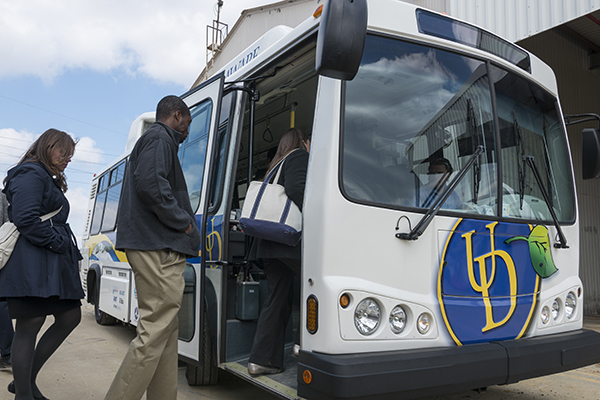Study investigates use of solar on hybrid fuel cell shuttle buses
Solar panels are popping up everywhere from rooftops and roads to highway signs and even cars.
At the University of Delaware, a team of researchers has begun to investigate the use of solar power on the fuel cell bus fleet as a way to reduce operating costs without increasing greenhouse gas emissions.
The program currently includes two 22-foot, 22-seat transit buses equipped with nickel-cadmium batteries to meet the power demand of the buses and hydrogen-fueled proton exchange membrane fuel cells to maintain the state of charge of the batteries.
“The additional power produced by the roof-installed photovoltaic array can supplement the battery in meeting power demand and the fuel cell in charging the battery,” says Babatunde Ogunnaike, the William L. Friend Professor of Chemical and Biomolecular Engineering at UD.
But hybrid systems require a delicate dance among sometimes competing objectives — in this case, satisfying bus power demand instantly at all times while also maintaining the battery state of charge at an optimal 65 percent — under varying environmental and driving conditions.
Add in solar, and you also have to contend with the unpredictable variability in solar power.
Appropriately designed controllers can provide a solution, but which type is most effective?
To answer these questions, Ogunnaike teamed with Ajay Prasad, Engineering Alumni Distinguished Professor of Mechanical Engineering and director of UD’s Center for Fuel Cell Research, to demonstrate the design, implementation and performance of the three-way hybrid system via simulation of real shuttle runs under various operating conditions.
They also conducted an economic analysis to determine whether solar would be a cost-effective addition to the bus.
Their findings are reported in a paper, “Design, Operation, Control, and Economics of a Photovoltaic/Fuel Cell/Battery Hybrid Renewable Energy System for Automotive Applications,” which appeared in the web version of the journal Processes on June 9.
The team considered two separate control strategies: an “algebraic” control strategy and standard proportional-integral (PI) control.
Ogunnaike explains that the algebraic controller is based on straightforward logic of matching power demand to available supply. “As a consequence, control decisions are based on simple algebra, without consideration for the often important difference between the point at which control action is taken and when its effect is felt by the system — known as system dynamics,” he says.
“On the other hand, the proportional-integral, or PI, control is based on a standard algorithm that takes such system dynamics into consideration.”
The performance and effectiveness of the two strategies were evaluated under three operating conditions: first, under typical operating conditions in terms of solar irradiance, vehicle speed, and ambient temperature during summer and winter; second, during sudden changes in cloud cover; and third, with a sustained increase in bus speed.
“What we found is that the two control strategies perform equally well under typical operating conditions and under sudden cloud cover conditions,” says Ogunnaike. “However, at consistently high bus speeds, battery state-of-charge maintenance is better and the system consumes less hydrogen with PI control.”
The economic analysis indicates that the photovoltaic array modification to the bus will pay for itself while producing zero harmful emissions.
“UD’s fuel cell bus program has now completed a decade of existence with its two current buses accumulating a combined 14 years of service,” Prasad says. “The program has provided valuable research opportunities for a large number of undergraduate and graduate students, including two of the co-authors on this paper, Zachary Whiteman and Piyush Bubna.”
Whiteman completed his Ph.D. in Ogunnaike’s lab in 2015, and Bubna earned his master’s degree under Prasad’s advisement in 2010.
Two new, advanced fuel cell hybrid buses will be added to the UD fleet later this year, providing opportunities for additional research.


